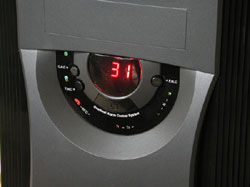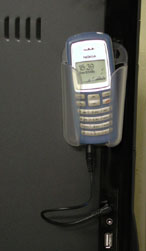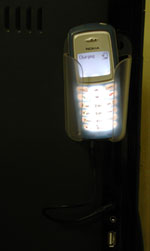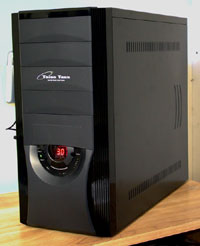|
|
Advertisement:
|
|
COMSCOM Think Tank Minitower Case |
|
Join the community - in the OCAU Forums!
|
Panoramic Panel, Conclusions
Controlling all these connections is the front Panoramic Panel. The power button is located in the middle, beneath the round display.

Central to this panel is the temperature display. This reports, in Celcius only, the temperature currently reported by the three thermal probes provided with the case and plugged into the Hub Box. You can use these flat-type probes on anything really, from the back of your video card, to the top of your hard drive or perhaps the side of a radiator in a watercooling setup. There's no text to dictate which you should use for which - they are simply referred to as T1 through T3. The display is bright and easy to read and you cycle manually through the three temperatures by pressing the TMC (Temperature Monitoring Control) button, the lower of the two left ones.
Another feature is "CAC", which apparently and somewhat oddly stands for "After Cooling Function". This simply keeps the fans connected to the Hub Box spinning for 3 minutes after the PC shuts down. This explains why the motherboard ATX power passthrough cable is used - the fans must be powered by the ATX standby power of +5v during this time. This power is not available through the normal Molex connectors, only to the motherboard. 5v is not enough to start some fans expecting 12v, but virtually all fans will keep spinning slowly once the voltage drops to 5v. Of course, if you turn your PC off at the PSU this feature will not function. There's no way to turn this function off or change the period of time involved, and there's always some debate about how useful it is to keep cooling the PC after it has stopped producing heat, but it's certainly not going to do any harm. In this state the front panel changes to display AC, for "After Cool".
FNC or "Fan Noise Control" is of perhaps more interest, allowing you to choose between three speed settings for the two fans connected to the Hub Box. This handy feature is controlled by the rightmost button on the Panoramic Panel. You can make your PC run quietly during low-power times such as checking your email or surfing the web, then crank up the fan speed (and hence the noise) when you need more cooling while playing a game or similar.
The final button is for OAC or "Overheat Alarm Control". This allows you to select from three pre-set threshholds of 45C, 55C or 65C. If any of the thermal probes report above your selected threshhold, the PC emits a beeping alarm, similar to a PC speaker BIOS alert but not quite as loud, until the temperature drops. To test this, I set the alarm to 45C, wedged one of the probes between the fins on the CPU heatsink and unplugged the CPU fan for a few minutes. You certainly couldn't miss the alarm sound if you were using the PC or even in the next room in a quiet house, but I don't know if it would wake you up from elsewhere in the house. It does keep beeping endlessly though, so you'd notice it eventually if the temperature didn't drop. Given that the ATX power-on switch goes through the Hub Box, I'm surprised COMSCOM didn't add the further functionality to simply turn the PC off, perhaps 30 seconds after the alarm has sounded. Closing the power-on connection for 5 seconds should turn the PC off from almost any state and could possibly save components if things have really gone bad in the cooling system.
 
This front panel also has an LED to show when the mobile phone charger is operating. It's green when disconnected or fully charged and changes to red when charging. I tested it with my Nokia 2100 and it worked fine. Watching the PC's voltages during use didn't reveal any worrying effects of plugging in the phone while the PC was running. However, I think if you were setting out to break your overclocking record one afternoon you probably want to charge your phone elsewhere, given this is powered from the motherboard ATX connector. The little plastic caddy is so designed that you can remove the case side panel while leaving the caddy attached to the case.
Conclusions:
Here's the case in action:

I'll admit I have been quite spoiled lately, with my last two reviews being the much more expensive Lian Li PC-6077 and Antec P160. The P160 for example retails for about AUD $240, while the Think Tank's RRP is USD $45 to $50. COMSCOM have produced what is primarily a budget case, but with some quite handy extra features. There are certainly some penalties paid for being in this price bracket, in that you don't get a dust filter, a removable motherboard tray or similar features. Unsurprisingly, you don't get the feeling of luxury that the top-end cases provide - but it's certainly not a cheap and nasty clone case that you'll end up hating. If and when this case becomes available in Australia it is definitely worth considering, if you are after an inexpensive case with fan control and thermal monitoring features. Producing a budget case which is aimed at overclockers and enthusiasts is a tough target to hit, but I think COMSCOM have come pretty close with their Think Tank.
Thanks to COMSCOM Corporation for providing the review sample.
|
|
Advertisement:
All original content copyright James Rolfe.
All rights reserved. No reproduction allowed without written permission.
Interested in advertising on OCAU? Contact us for info.
|

|


